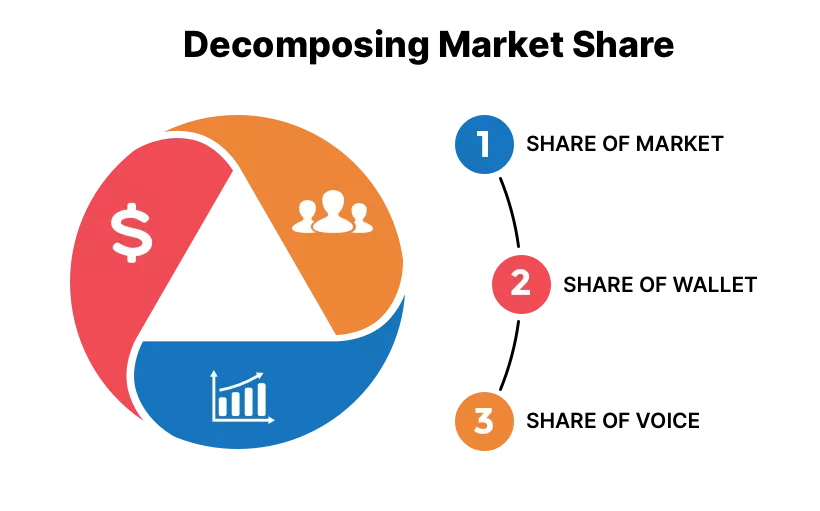What is meant by market share? The answer you are most likely to give is simple. Market share is the share of the market occupied by the company. But is it that simple? Actually, there are different approaches towards market share. By decomposing market share, we will obtain a deeper understanding of these different approaches.
Before decomposing market share, let’s look at the general definition of market share. Market share can be defined as the proportion of the overall market for a given category of product, held by a specific organization. Simple as that. Is there more to it? In the next step, different approaches towards market share will be differentiated.
The concept of market share can be decomposed into three sections.

Firstly, we can look at market share as the overall share of the market as compared with competitors. This can be an absolute percentage, but can likewise be expressed as a relative number. For instance, in the BCG-matrix, we consider relative market share.
Secondly, market share can be understood as the share of wallet. This means the share of the target consumers’ total expenditure.
Thirdly, market share may refer to the share of voice, which is the measure of a company’s advertising expenditure compared with competitors.
For most marketers, the key measure tends to be overall market share compared with competitors. This is why, when thinking of market share, the first definition will come to your mind. But by decomposing market share, we can see that there is more to it than only this definition.
The point of measuring market share is to see how effective competitive strategies are: if the share is increasing, the strategy is working, whereas if the share is falling the competitors are using more successful approaches. Of course, a growth in sales does not necessarily mean that market share is also increasing – if the market is growing, sales will increase even if the share of the market does not, and in a rapidly growing market a firm can be increasing sales while losing market share, as competitors’ sales grow even faster. That is why growing sales can lead managers into a false sense of security, imagining that all is well when in fact competitors are forging ahead.
Because of such traps, it makes sense to consider more than just the overall share of the market occupied by the company. Decomposing market share can thus help to get a more complete image of the company’s performance in relation to competition.
In the following, we will continue decomposing market share by investigating the two less common approaches towards market share.
Share of wallet refers to the amount of a consumer’s total disposable income that is spent on the firm’s products. This is a useful measure as it shows the degree to which the individual values the company’s brands, and is likely to be a good surrogate measure for involvement.
A person who spends a large proportion of their disposable income on a company’s products is obviously fairly committed to the brand. Share of wallet is a relatively recent concept. The less frequent use may be explained by the fact that it is difficult to research effectively since the parameters are hard to set and the data difficult to collect.
Share of voice is an indicator of the degree to which a firm’s marketing communication will be effective. It measures the relative expenditure on advertising of each company, providing an overall estimate of the extent to which each firm is likely to get its message through to potential customers.
Why is share of voice not used that often? Well, it is a somewhat clumsy measure, because it does not take account of the relative effectiveness of advertising campaigns. What it does is provide a guideline for firms in terms of budgeting. For example, if a company aims to capture a 30% share of the market, it needs to plan on gaining at least a 30% share of voice.
Obviously, there is an inherent assumption that increasing advertising expenditure will also increase market share, and although this is probably the most likely outcome it is not necessarily the case. Clearly, there are too many other factors involved in marketing a product. Not least of these is consumer acceptance of the product: if consumers do not like the product, no amount of advertising will persuade them otherwise. Also, there are many more marketing communications tools that may have an effect on consumers.
Overall, decomposing market share helps to obtain a more complete picture of the effectiveness of marketing campaigns. This in turn helps in planning, both from a budgeting viewpoint and from the wider strategic viewpoint.

Email subscription is available ONLY TODAY (oh, okay, and tomorrow).
Surely, we respect your inbox! Unsubscription works every day.